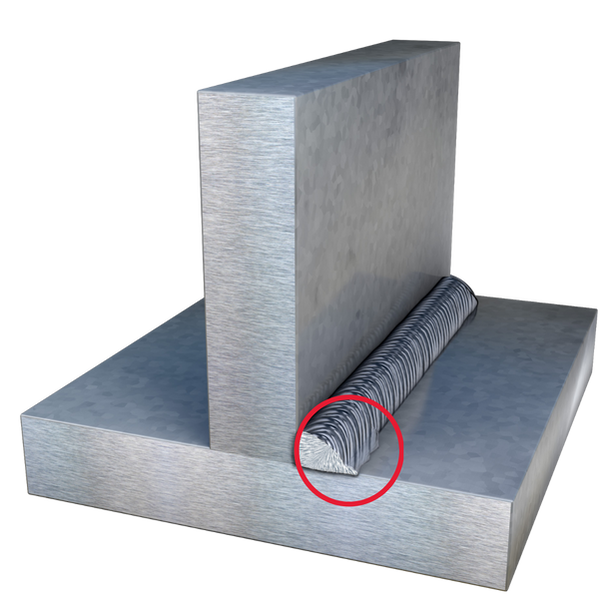Step-by-Step Overview to Preventing Weld Undercut in Different Metals
Step-by-Step Overview to Preventing Weld Undercut in Different Metals
Blog Article
Comprehending the Causes and Solutions for Undercut Welding in Steel Construction Procedures
In the world of steel manufacture procedures, the event of undercut welding postures a substantial obstacle that requires a thorough understanding of its reasons and sensible remedies. The detailed interaction of numerous variables throughout welding procedures can cause this unfavorable phenomenon, impacting the structural honesty and total top quality of the bonded joints - Preventing weld undercut. By exploring the origin of undercut welding and discovering reliable therapeutic procedures, producers can elevate the standard of their workmanship and ensure the manufacturing of perfect metal parts
Typical Sources Of Undercut Welding
Frequently overlooked in steel construction, undercut welding occurs as a result of different factors that require precise attention and proficiency to be properly alleviated. One common root cause of undercut welding is extreme warmth input. When the warm input is too expensive, it can cause the melting and subsequent disintegration of the base material along the edges of the weld joint, developing a groove or undercut. Furthermore, inappropriate welding methods, such as making use of the wrong welding angle or take a trip speed, can additionally add to damage formation. Inadequate protecting gas coverage is one more key aspect that can result in undercutting. Not enough gas coverage falls short to safeguard the weld swimming pool effectively, leading to oxidation and undercut flaws. Moreover, the option of welding criteria, such as voltage, current, and cable feed rate, plays a significant role in the incident of undercut welding. Recognizing these common reasons is essential for carrying out safety nets and making sure high-quality welds in metal construction procedures.
Effect of Incorrect Welding Parameters
Incorrect welding criteria can significantly jeopardize the honesty and top quality of welded joints in metal manufacture procedures. The impact of inaccurate welding specifications shows up in various ways, leading to structural weak points and issues in the welded components. Precise interest to welding parameters is paramount to guarantee the production of top notch welds with the wanted mechanical buildings and structural integrity.
Effect of Improper Torch Angle
Inappropriate lantern angle in welding operations can significantly impact the quality and honesty of the last weld joints in metal fabrication procedures. Damaging is a typical welding defect where a groove creates along the weld toe, damaging the joint and jeopardizing its architectural integrity.
A torch angle that is as well high can cause inadequate penetration, incomplete blend, and raised spatter. On the various other hand, a torch angle that is too shallow can result in excessive infiltration, burn-through, and distortion of the base material. Preventing weld undercut. Proper lantern angle is crucial for making certain constant weld quality, toughness, and look
To avoid undercutting and various other problems brought on by inappropriate torch angles, welders must be educated to maintain the proper torch angle throughout the welding procedure. Routine surveillance and change of torch angles throughout welding can help attain sound welds with marginal flaws.
Role of Inadequate Welding Methods

One go to my site more element of inadequate welding techniques is improper weld preparation. Poor cleansing of the base metals, inaccurate joint design, or insufficient edge prep work can all add to damage welding. Additionally, insufficient shielding gas coverage or making use of the incorrect sort of gas can result in insufficient blend and the development of undercut problems.
To attend to the function of poor welding methods in metal fabrication procedures, it is important to offer detailed training for welders. Appropriate education on welding criteria, joint preparation, and shielding gas option can assist prevent undercut welding and make certain top notch welds in metal construction projects.
Reliable Solutions for Undercut Welding
Dealing with undercut welding in steel construction requires carrying out effective remedies to enhance weld top quality and structural honesty. One of the key solutions to battle undercut is to change welding criteria such as voltage, current, and take a trip speed to make sure proper warm input and blend. By fine-tuning these settings, welders can stop excessive melting of the base metal and filler product, decreasing the likelihood of undercut formation.
In addition, correct joint preparation is critical in avoiding undercut. Making certain clean base metal surface areas without pollutants and utilizing the ideal bevel angle can assist advertise better weld penetration and minimize the threat of undercut - Preventing weld undercut. Employing appropriate welding strategies, such as oscillating the torch or weaving, can likewise help in dispersing warm equally and filling the weld joint appropriately, reducing the possibility of undercut flaws
In addition, picking the correct welding consumables, including electrodes and filler metals, is vital in alleviating undercut. Making use of materials with suitable chemical structures and mechanical homes can add to accomplishing audio welds with this post very little undercut. Routine assessment and quality assurance actions need to additionally be applied to identify and resolve undercut concerns without delay, making certain the total honesty of made steel elements.

Conclusion
Finally, understanding the reasons and remedies for undercut welding in steel construction processes is essential for achieving high-quality welds. By addressing usual reasons such as inaccurate welding parameters, inappropriate lantern angle, and inadequate welding techniques, welders can protect against damaging and guarantee solid, sturdy welds. It is crucial to pay interest to these elements and implement reliable options to improve the total welding process and end product quality.

Report this page